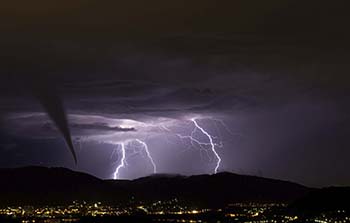The tornado that ravaged Moore, Okla., on May 20, 2013, was another reminder that Mother Nature has a temper. Experts at the University of Alabama at Birmingham (UAB) have said fighting complacency and preparing for what is ahead are important.
 UAB Department of Health Care Organization & Policy Assistant Professor Lisa McCormick, Dr.P.H., said people – whether they live in areas of rare or frequent tornado activity – often disregard the dangers.
UAB Department of Health Care Organization & Policy Assistant Professor Lisa McCormick, Dr.P.H., said people – whether they live in areas of rare or frequent tornado activity – often disregard the dangers.
“When the probability of an event occurring is small, and there is a lesser chance you will be affected if that event occurs, people become complacent,” McCormick said. “False alarms have the same effect.”
Mass media coverage, like that following the Moore tornado, as well as the tornadoes that hit Alabama on April 27, 2011, and Joplin, Mo., on May 22, 2011, can help increase sensitivity.
“Research has shown that people become more aware of the need to be prepared after events occur, even if the event didn't occur in their own community,” McCormick said. “If the event is catastrophic, there is more media coverage for a longer period of time, reinforcing the need to be prepared.”
While there is never a guarantee of 100 percent safety from a tornado, McCormick shared several ways to be ready for the worst.
- Start with a plan. Decide now what you would do if a tornado warning is issued while you are at home, work or out and about. At home, the basement or an interior bathroom with no windows on the lowest floor of your home is safest; if you live in a top floor apartment, get as low in the building as possible, and get to know your neighbors that live on the bottom floor. If you live in a trailer, find out if there is a nearby tornado shelter, church with a basement, or a structural frame or masonry home or building. Whatever your situation, decide now what you would do to find shelter.
- Assemble a disaster preparedness kit. If severe weather strikes your community, you might not have access to food, water or electricity for some time, so gather these and other basic supplies like a first aid kit and battery-powered radio.
- Stay informed. If your power goes out, have a battery-powered weather radio that will allow you to get weather alerts. Learn what warning systems are in place in your community, and make sure you can hear warning alerts at home, work, school and other places you might frequent.
- Do not forget the kids. Learn your children’s school or day care policies, and ask how they plan to shelter-in-place during a severe weather outbreak. Understand their evacuation policies and procedures, as well as how you will be notified if they evacuate to an alternate location. Talk with children about what to do while at home during a tornado warning, and practice sheltering-in-place at home, just like they do at school.
- Protect your head. Children and adults should have helmets on the ready to prevent injury or death, according to research conducted by scientists at the UAB Injury Control Research Center following the deadly 2011 Alabama tornadoes. Any structurally sound helmet, such as a motorcycle helmet, football helmet, baseball helmet, bicycle helmet, skateboard helmet or even a construction hardhat, will do, as long as the helmet’s original intended purpose is to minimize anatomical damage sustained as a result of high-velocity impacts.
